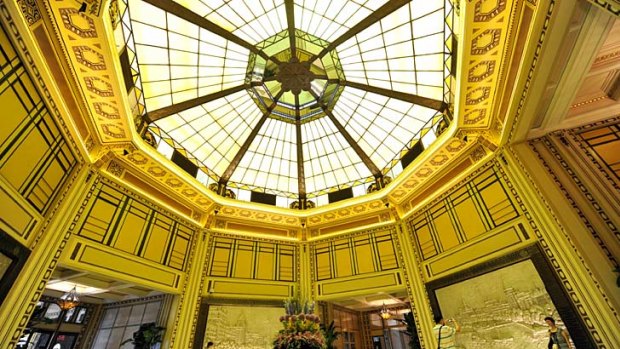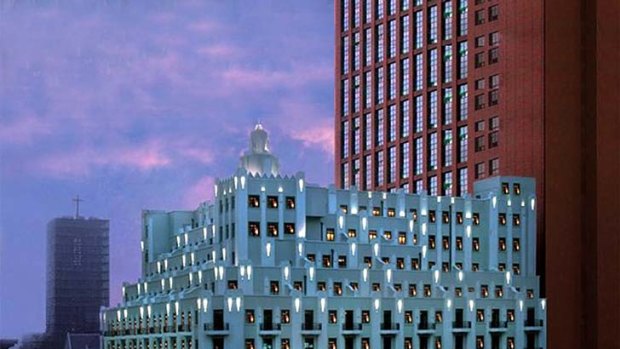
Glamour girls ... the Fairmont Peace Hotel's restored atrium.Credit: AFP
Andrea Black finds that modern Shanghai is embracing its old art deco buildings.
It's dark when I arrive in Shanghai. The LCD screens and neon lights flash and zip around skyscrapers as the taxi speeds along the elevated expressway from Shanghai Pudong Airport. Out the window, a high-speed Maglev train zooms by at 430 kilometres an hour. A slogan across a billboard from the 2010 World Expo promises a "Better City, Better Life". As we drive near Pudong, Shanghai's business hub, the driver points to the Grand Hyatt, housed in the Jin Mao Tower, one of Shanghai's 2000 buildings that are more than 100 metres high. He says it has the world's longest laundry chute.
"Eighty-eight floors - all the way from the top to the basement - and there's a swimming pool up there somewhere, too," he says.

The Langham Yangtze Boutique hotel.Credit: AFP
By next morning, I'll see Shanghai in a different light. Amid the Blade Runner-like modernity is a resurgent interest in the city's architectural history, namely the art deco period.
"Art deco, to a great extent, is the image of Shanghai," a Texan expat who runs architectural tours in the city, historian Spencer Dodington, says. While the rest of the world was sinking into the Great Depression in the 1930s, Shanghai was prospering. During this period, it became a haven for artistic and architectural talent eager to make the city a modern metropolis.
There are parallels between the Shanghai of the '30s and today. To see "Old Shanghai" in its glory, Dodington recommends I head to the Fairmont Peace Hotel on the Bund. Restorers are resurrecting the city's golden era and something of the reckless glamour of the 1920s and 1930s is returning to the Bund, the famous 1.5-kilometre promenade on the Huangpu River, across the water from the superstructures of Pudong.
In a city where vast areas have been razed to make way for monoliths, the Bund is one pocket of Shanghai where the wrecking ball has at least temporarily stopped.
"The Peace Hotel is a total work of art," Dodington says. "Despite several renovations, the interior is still the most stunning of the several good ones left. The architects designed everything from bins to lamps to teacups, as well as the exterior and structure."
Once known as the Cathay Hotel, this was where Charlie Chaplin and literary luminaries such as George Bernard Shaw and Noel Coward came to stay. The latter penned his comedy Private Lives in the penthouse. One writer, Emily Hahn, would sit at the bar accompanied by her pet gibbon, Mr Mills.
Walking into the ape-free Jasmine Lounge at cocktail hour, I can imagine the hotel's flamboyant founder, Sir Victor Sassoon - whose family made a fortune in the opium trade - throwing elaborate soirees in the private club and slinging gin with the well-heeled clientele. A stroll through the hotel's museum, known as the Peace Gallery, shows photographs of the tycoon with the glamour set, full of smiles. This period of gaiety was short-lived, however. The hotel went into decline when Japanese forces invaded China in 1937; the building survived the Chinese Revolution that followed but slowly deteriorated in its dual role as hostel for visiting Communist dignitaries and office space.
The hotel's heritage consultant, Jenny Laing-Peach, tells me Fairmont was able to restore 80 per cent of the building in its recent three-year refurbishment. A false ceiling was removed, eight layers of paint stripped back and the domed ceiling of the atrium, with its glass rotunda, has been restored. In some cases, approximations had to be made; many historical photographs and documents were destroyed during the Cultural Revolution. In some cases, architects have had to rely on sketchy first-person descriptions to determine replications.
Another noteworthy art deco structure is the Park Hotel Shanghai around the corner on Nanjing Road. It was, for 50 years, the tallest building in Shanghai. Built in 1934 by prolific Hungarian architect Laszlo Hudec, the 22-storey building was modelled on the American Standard Building in New York. It is one of more than 65 structures the architect designed during the 1930s, the peak of his career. There is talk of turning his former residence in the French Concession district into a museum; for now, there's a small museum dedicated to his work on the mezzanine level of the Park Hotel.
Other art deco treasures from the 1930s still in use are the Paramount, a dancehall showcasing the linear symmetry of the design style, and the Cathay Theatre, still showing movie matinees, its neon-lit spire easily spotted.
Shanghai's golden years are powerfully evoked at the Langham Yangtze Boutique. Walk through the hallway to the lobby and it's easy to imagine the days when jazz bands played on the dance floor at the base of the spiral staircase.
This is the spot where one of China's most popular songs, Rose, Rose I Love You, was written and performed in 1940 by Yao Lee, now aged 90.
Every night at 7.05 precisely, a singer dressed in traditional qipao summons up the spirit of the age by singing the hit in the lobby by a grand piano. On a screen in the upstairs bar, silent films play on a loop.
The director of communications at the hotel, Tony Wang, is passionate about re-creating the era for guests. Over a lunch of hairy crab, he tells me he trawled auction houses and websites to collect the authentic framed ephemera hung in the hotel's corridors: swizzle sticks, elegant gloves, beaded purses and fur stoles.
Across the road, the city's Urban Planning Exhibition Centre displays the shiny new Shanghai of the future. On the third floor is an astonishing scale model of a vision of the city in 2020. One of the ideas is that anyone living in a high-rise apartment will be able to walk to a park within 10 minutes. My guide jokes that residents visit the centre just to check if their apartment will still be there in eight years.
Next evening, I return to the Fairmont Peace Hotel's Jazz Bar to see the Old Jazz Band - average age, 77. They play standards twice a night to a packed room. Standing outside the hotel, I peer across the Huangpu River to the hyper-modern Pudong skyline. In the Jin Mao Tower, Hyatt guests are swimming on the 57th floor. I understand why Dodington describes Shanghai as "a visual symphony of contrast and change".
Back on the sprung floorboards of the Jazz Bar, I order a gimlet and enjoy a rusty rendition of Those Were the Days.
Andrea Black travelled courtesy of Langham Hotels.
FAST FACTS
Getting there
Air China flies to Shanghai from Sydney and Melbourne (about 11hr non-stop) for about $735 low-season return, including tax; see airchina.com. Australians require a visa for a stay of up to 30 days.
Touring there
Spencer Dodington runs private guiding services, including half-day, full-day or tailor-made itineraries; see luxuryconciergechina.com.
Staying there
Langham Yangtze Boutique hotel has double rooms from 1900 yuan ($252) a night; see yangtzeboutique .langhamhotels.com.
Fairmont Peace Hotel has double rooms from 1700 yuan a night; see fairmont.com/peacehotel.
The Park Hotel Shanghai has double rooms from 661 yuan a night; see parkhotelshanghai.cn/.
The Park Hyatt Shanghai has double rooms from 2160 yuan a night; see shanghai.park.hyatt.com.
Sign up for the Traveller Deals newsletter
Get exclusive travel deals delivered straight to your inbox. Sign up now.